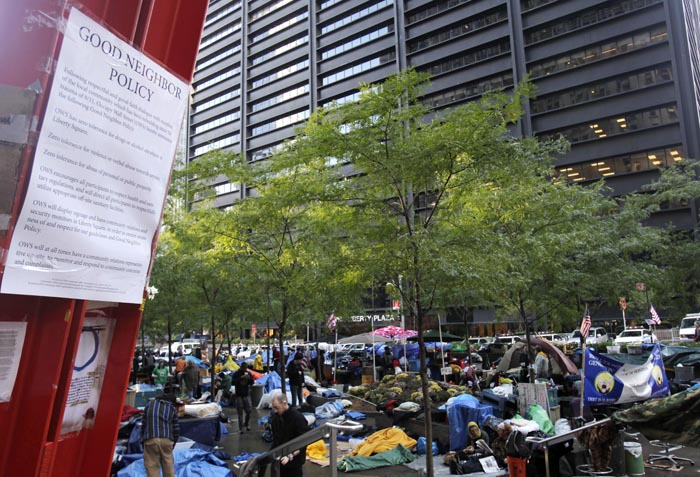NEW YORK — For the activists of Occupy Wall Street, the plaza of Zuccotti Park has become their home away from home. But it’s safe to say the corporation that owns the plaza never envisioned having these kinds of houseguests.
Brookfield Office Properties owns Zuccotti Park, a granite space near Wall Street that, until recently, was a quiet outdoor plaza where New Yorkers occasionally ate lunch or relaxed on a bench. A highly respected real estate power player, Brookfield now finds itself in an unprecedented quandary: How to keep the public from using a space that is, well, for the public.
“It was meant to be a major public space in the Wall Street area,” said Ross Sandler, a professor at New York Law School. “That was the purpose of it.”
The company has won praise for good security at its properties, yet has fumbled in efforts to break up the encampment known as “Occupy Wall Street.” Its options are limited because Zuccotti Park is one of more than 500 “bonus plazas” in the city: privately owned public parks borne of a little-known compromise struck in 1961 between the city and developers.
Brookfield, which declined to comment for this story, has in recent months enjoyed a good run of business acquisitions in the New York area.
It recently unveiled plans for a $250 million retail development of the World Financial Center, piling onto the more than 100 properties it already owns in several cities, including Toronto and Sydney. Brookfield also owns a majority stake in the Manhattan building that houses The Associated Press’ world headquarters.
In 2004, Brookfield was among dozens of corporate donors that helped raise about $70 million for the Republican National Convention in New York. In 2000, it donated $50,000 to then-Mayor Rudolph Giuliani for his run for the U.S. Senate, which was later aborted. And current Mayor Michael Bloomberg’s girlfriend, Diana Taylor, is on Brookfield’s board of directors.
One Liberty Plaza, the Brookfield-owned skyscraper that looks out upon Zuccotti Park, is home to major financial firms like the Royal Bank of Canada. There’s also a Brooks Brothers retail store on the ground level.
The idea of Zuccotti Park took root in 1968, when U.S. Steel Corp. wanted to build a 54-story building — what later became One Liberty.
But the rule established in 1961 called for developers who want to build a tall building to construct a plaza to provide “light and air” that otherwise would have been blotted out by a towering skyscraper. The bigger the plaza, the more zoning concessions a company could reap.
City officials loved the idea of an open landscaped area right near the New York Stock Exchange.
The park, originally named Liberty Plaza, was destroyed during the World Trade Center collapse on Sept. 11, 2001, and reopened in 2006. It was renamed after John Zuccotti, chairman of Brookfield’s board of directors.
Virtually all bonus plazas are required to be open 24 hours a day, barring a safety issue. And police must be invited in by the owner, just as a homeowner would have to.
And until now, nobody has ever tried to occupy one for days on end. With the campers — who are clamoring against what they say is unfair distribution of wealth, among other concerns — showing no sign of leaving anytime soon, the city is venturing into murky depths of zoning laws that were hitherto unexplored.
If the protesters are ultimately kicked out of the park, there are myriad other similar plazas around the city, though many are smaller.
The closest one to Zuccotti Park is at 140 Broadway, notable for its modernist red cube designed by landscape architect Isamu Noguchi. There’s also the General Motors plaza on Fifth Avenue, home to the Apple store and its famous glass-cube structure. And there’s the McGraw-Hill Plaza near Times Square, where New Yorkers can enjoy free concerts in the summer.
And some experts think bonus plazas are ushering in a new chapter of activism in the city’s history.
“I finally think these spaces have a purpose in life,” said Gregory Smithsimon, an assistant professor of urban sociology at Brooklyn College.
Send questions/comments to the editors.



Comments are no longer available on this story